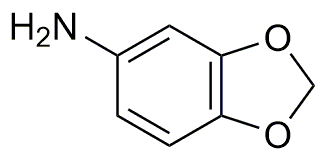3,4-Methylenedioxyaniline is widely utilized in research focused on:
- Dyes and Pigments: This compound serves as a precursor in the synthesis of various dyes and pigments, particularly in textiles and inks, offering vibrant colors and excellent stability.
- Pharmaceuticals: It is used in the development of pharmaceutical intermediates, contributing to the formulation of drugs that target various health conditions, thus enhancing therapeutic efficacy.
- Polymer Chemistry: The compound plays a significant role in creating specialty polymers, which are used in coatings and adhesives, providing improved durability and performance compared to traditional materials.
- Electronics: In the electronics industry, it is utilized in the production of conductive polymers, which are essential for manufacturing flexible electronic devices, enhancing their functionality and versatility.
- Research Applications: It is employed in various research studies, particularly in organic synthesis and materials science, allowing researchers to explore new chemical reactions and develop innovative materials.
General Information
Properties
Safety and Regulations
Applications
3,4-Methylenedioxyaniline is widely utilized in research focused on:
- Dyes and Pigments: This compound serves as a precursor in the synthesis of various dyes and pigments, particularly in textiles and inks, offering vibrant colors and excellent stability.
- Pharmaceuticals: It is used in the development of pharmaceutical intermediates, contributing to the formulation of drugs that target various health conditions, thus enhancing therapeutic efficacy.
- Polymer Chemistry: The compound plays a significant role in creating specialty polymers, which are used in coatings and adhesives, providing improved durability and performance compared to traditional materials.
- Electronics: In the electronics industry, it is utilized in the production of conductive polymers, which are essential for manufacturing flexible electronic devices, enhancing their functionality and versatility.
- Research Applications: It is employed in various research studies, particularly in organic synthesis and materials science, allowing researchers to explore new chemical reactions and develop innovative materials.
Documents
Safety Data Sheets (SDS)
The SDS provides comprehensive safety information on handling, storage, and disposal of the product.
Product Specification (PS)
The PS provides a comprehensive breakdown of the product’s properties, including chemical composition, physical state, purity, and storage requirements. It also details acceptable quality ranges and the product's intended applications.
Certificates of Analysis (COA)
Search for Certificates of Analysis (COA) by entering the products Lot Number. Lot and Batch Numbers can be found on a product’s label following the words ‘Lot’ or ‘Batch’.
Numéro de catalogue
Numéro de lot/série
Certificates Of Origin (COO)
This COO confirms the country where the product was manufactured, and also details the materials and components used in it and whether it is derived from natural, synthetic, or other specific sources. This certificate may be required for customs, trade, and regulatory compliance.
Numéro de catalogue
Numéro de lot/série
Safety Data Sheets (SDS)
The SDS provides comprehensive safety information on handling, storage, and disposal of the product.
DownloadProduct Specification (PS)
The PS provides a comprehensive breakdown of the product’s properties, including chemical composition, physical state, purity, and storage requirements. It also details acceptable quality ranges and the product's intended applications.
DownloadCertificates of Analysis (COA)
Search for Certificates of Analysis (COA) by entering the products Lot Number. Lot and Batch Numbers can be found on a product’s label following the words ‘Lot’ or ‘Batch’.
Numéro de catalogue
Numéro de lot/série
Certificates Of Origin (COO)
This COO confirms the country where the product was manufactured, and also details the materials and components used in it and whether it is derived from natural, synthetic, or other specific sources. This certificate may be required for customs, trade, and regulatory compliance.


